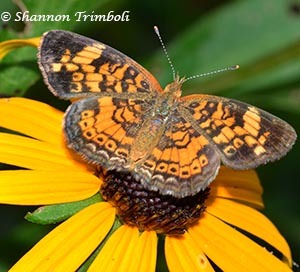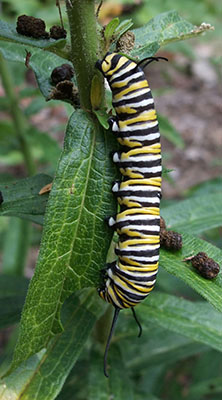Butterfly gardens are growing in popularity. When done properly, they can be a great way to attract these beautiful pollinators to your yard. Here are seven tips to keep in mind as you are planting for butterflies.

1) Think about what species of butterflies you want to attract.
Different species of butterflies require different food sources as either caterpillars or as adults. Some butterflies and caterpillars will use a wide variety of plants. Others are picky eaters and need specific plants either as caterpillars or as butterflies. If you don’t care what species of butterfly you attract, then the specific species of flowers you plant aren’t as important but still see tip #2. If you want to attract specific species of butterflies, then you’ll need to find out what they eat and make sure you grow those species of plants.
The University of Kentucky Department of Entomology and the University of Kentucky Department of Horticulture have web pages that list some of Kentucky’s common butterflies. These lists have pictures of the butterflies and you can learn more by clicking on the picture. The Society of Kentucky Lepidopterists has a much more complete list of butterfly species that can be found in Kentucky. However, you have to click on the name of each butterfly to get a picture and more information about the species.
2) Provide host plants for the caterpillars.
Butterflies, like all animals, have different requirements during each stage of their lives. Providing for their needs at each stage of their life will ensure that the butterfly population in your yard continues to thrive.
Some plants, like butterfly bush, are used by adult butterflies but none of our native caterpillars will eat it. Incorporating native plants into your garden and landscape can help ensure that you are providing forage for the caterpillars of at least some butterfly species because our native butterflies evolved with our native wildflowers.
Many caterpillars can only eat plants from certain genera or families. Monarch caterpillars are a good example because they can only eat milkweeds. Therefore, if you want to attract monarchs, it is important to provide milkweeds for the caterpillars to eat even though the adult butterflies will drink nectar from many different flower species.
3) Leave overwintering areas.
Most of our butterfly species overwinter as pupae. In the fall, the caterpillar crawls away from its host plant, crawls up another plant, and forms a chrysalis. It will overwinter as a chrysalis and emerge as a butterfly in the spring. However, if you cutback and discard all of the standing dead vegetation then you will unintentionally also get rid of any chrysalises that may be in the vegetation. If you can’t leave all of your dead vegetation standing until spring, try to at least leave some in a back corner of your yard that isn’t seen too often. If anyone says anything, tell them it is your butterfly winter refuge.

4) Plant clumps of flowers.
Clumps of flowers are aesthetically more pleasing than scattered individual flowers. They are also more attractive to butterflies. Butterflies will be more likely to notice a clump of the same type of flowers, than they will be to notice single flowers. The more the butterflies notice your clump of flowers, the more they will use it. A clump size of at least 3 feet by 3 feet is considered ideal for attracting pollinators.
5) Plan to have at least three species of flowers blooming in each season.
Individual butterflies don’t live very long, sometimes only for a couple of weeks after emerging as a butterfly. Successive generations are why we see some of the same species all summer long. It is, therefore, important to make sure the butterflies have flowers available throughout the growing season. When planting for pollinators, including butterflies, it is recommended that you have at least three species of flowers blooming in the spring, summer, and fall. Having three different species blooming in each season provides a greater variety of options for the pollinators and will hopefully provide a continuous supply of blooms.
6) Create puddling and sunning spots.
Puddling spots are areas of wet, bare ground. Small mud puddles are perfect puddling spots. The butterflies can drink the water they need and get trace salts and minerals from the soil. Butterflies also like to have sunning spots where they can spread their wings and warm up in the sun. Sunning spots are easy to create. A flat rock in a sunny spot provides a very easy and simple sunning spot. Flowers with large flat tops can also serve as sunning spots.
7) Don’t use pesticides in the butterfly garden.
It should go without saying, but I’ll say it anyway. Don’t use pesticides in your butterfly garden or nearby. Even organic and “natural, homemade remedies” can be harmful to butterflies and their caterpillars. And please, if you see a bunch of caterpillars chowing down on your milkweed (or other plants), identify them before doing anything about them. Some caterpillars are economic or agricultural pests, such as tomato hornworms. Other caterpillars, such as the monarch caterpillars, don’t cause any significant damage. If you have identified it as a pest species, then do what you need to do. If it isn’t a pest species, then leave it alone because caterpillars have to eat too and without the caterpillars, there would be no butterflies.

This article was part of Shannon’s original Kentucky Pollinators and Backyard Wildlife blog which evolved into the blog for Backyard Ecology.

Backyard Ecology: Exploring Nature in Your Backyard
Nature isn’t just “out there.” It’s all around us, including right outside our doors. Hi, my name is Shannon Trimboli, and I am the host of Backyard Ecology. I live in southcentral Kentucky and am a wildlife biologist, educator, author, beekeeper, and owner of a nursery specializing in plants for pollinators and wildlife conservation. I invite you to join me as we ignite our curiosity and natural wonder, explore our yards and communities, and improve our local pollinator and wildlife habitat. Learn more or subscribe to my email list at www.backyardecology.net.

Leave a Reply